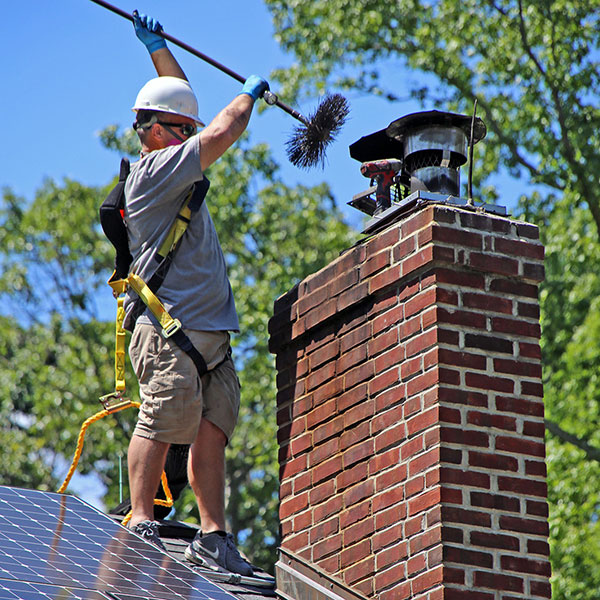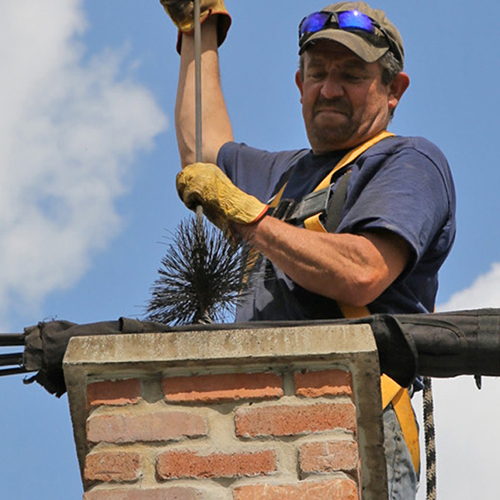Chimney Security First: Premier Chimney Clean San Jose Solutions Revealed
Chimney Security First: Premier Chimney Clean San Jose Solutions Revealed
Blog Article
Chimney Cleansing: A Step-by-Step Overview to Preserving a Healthy And Balanced Fireplace
Maintaining a healthy fire place is vital for the security and effectiveness of your home. Routine smokeshaft cleaning is a vital part of this upkeep routine. In this detailed guide, we will certainly supply you with thorough guidelines on exactly how to properly clean your chimney, making certain that it works optimally and reduces the risk of fire hazards. By complying with these guidelines, you will certainly learn exactly how to gather the needed tools, execute an aesthetic examination, clear particles and accumulation, sweep the chimney, and finish the last actions for recurring maintenance. With an expert approach and focus to information, you can with confidence care for your fireplace and enjoy its warmth and convenience for several years to find.
Collecting the Needed Tools
To start the procedure of chimney cleansing, the very first step is to gather all the needed tools. Having the right devices available makes certain a reliable and risk-free cleaning process. The necessary tools for smokeshaft cleaning consist of a chimney brush, a ladder, ground cloth or plastic sheets, a flashlight, gloves, and a dust mask.
The chimney brush is the main device used to get rid of residue and creosote buildup from the flue - Chimney Sweep San Jose. It is vital to choose a brush that matches the size and form of your smokeshaft.
A flashlight is important for checking the chimney's inside for any type of indicators of damages or blockages. Gloves are necessary to shield your hands from residue and various other unsafe substances, while a dust mask helps stop the breathing of particles.
Performing a Visual Inspection

Making use of a flashlight, carefully analyze the indoor wall surfaces of the smokeshaft for any signs of damage, such as fractures, loose bricks, or mortar damage. These problems can compromise the chimney's structural stability and position a severe safety danger. In addition, look for any kind of indicators of water damages, such as staining or efflorescence, as this can show a leaky chimney cap or flashing.
Next, check the smokeshaft flue for any kind of blockages. Seek the visibility of nesting products, leaves, or particles that might have collected with time (Chimney Sweep San Jose). These blockages can limit air flow, boost the danger of carbon monoxide buildup, and hinder the chimney's capacity to properly air vent smoke
During the visual inspection, pay close attention to the smokeshaft crown, which is the top surface that protects the chimney from moisture. Search for cracks or missing out on items in the crown, as these can allow water to enter the smokeshaft and cause substantial damages.
Cleaning Debris and Accumulation
After finishing the aesthetic assessment, the next action in smokeshaft cleaning includes clearing particles and build-up to make sure the proper performance of the fire place. Over time, debris such as leaves, branches, and animal nests can gather in the chimney, obstructing the circulation of air and triggering possible fire risks.
To get rid of debris and build-up, it is necessary to use the right tools and methods. A smokeshaft brush, particularly made for this purpose, is utilized to get rid of loose debris and creosote from the smokeshaft wall surfaces. It is important to select a brush that matches the dimension of your smokeshaft to guarantee efficient cleansing. Prior to beginning the cleansing procedure, ensure to click for more info cover the fireplace open up to avoid particles from falling under the area.
To start, put the brush right into the chimney and move it up and down, scrubbing the wall surfaces to displace any kind of particles or creosote. When the brushing is complete, use a vacuum cleanser or a smokeshaft brush expansion to get rid of the dislodged debris from the fireplace.

Sweeping the Chimney
The sweeping of the chimney is an important action in preserving a healthy fireplace. In time, soot, creosote, and other debris can accumulate click now in the smokeshaft, blocking the circulation of air and possibly triggering a hazardous accumulation of flammable materials. Normal chimney sweeper not only ensures correct air flow however also prevents the risk of chimney fires.
When it concerns smokeshaft sweeping, it is very suggested to work with a specialist chimney sweeper. These discover this experts have the expertise and tools necessary to securely and properly eliminate the built up particles from your smokeshaft. They will usually begin by covering the fire place to avoid any residue or debris from entering your home. Using customized brushes and vacuum cleaner tools, they will after that cleanse the smokeshaft from leading to bottom, making certain that all the build-up is extensively removed.
It is important to keep in mind that the frequency of smokeshaft sweeping depends on a number of factors, such as the kind of gas used, the amount of usage, and the sort of smokeshaft. As a general regulation of thumb, it is suggested to have your smokeshaft examined and swept at the very least when a year.
Last Steps and Upkeep
After completing the chimney sweeping process, the initial step in the last upkeep is to inspect the chimney cap and spark arrestor. These components avoid debris, animals, and rain from getting in the smokeshaft.

Check the within the fire place for any signs of damage, such as cracks, loose bricks, or harmed mortar. These issues can affect the structural stability and security of the fire place. If any kind of troubles are discovered, consult a professional chimney sweep or mason to address them quickly.
Ultimately, think about setting up carbon monoxide gas detectors near the fireplace and throughout your home. These devices can discover the existence of this harmful gas, offering an early warning system in case of a smokeshaft breakdown. Consistently examine and replace the batteries in these detectors to ensure their efficiency.
Conclusion
To conclude, complying with a step-by-step guide for chimney cleaning is important in preserving a healthy fireplace. By gathering the necessary tools, performing a visual examination, clearing debris and accumulation, and brushing up the smokeshaft, property owners can make sure the safety and performance of their fire place. Routine maintenance and cleaning will certainly aid protect against smokeshaft fires and improve air high quality in the home. It is important to prioritize smokeshaft cleaning as a part of overall home upkeep.
The vital devices for smokeshaft cleansing include a smokeshaft brush, a ladder, drop towels or plastic sheets, a flashlight, gloves, and a dirt mask.
A chimney brush, especially made for this function, is used to get rid of loose particles and creosote from the chimney walls. Normal smokeshaft sweeping not just guarantees correct ventilation yet also stops the danger of chimney fires.
When it comes to smokeshaft sweeping, it is highly suggested to hire an expert smokeshaft sweep. After finishing the chimney sweeping procedure, the initial step in the last upkeep is to examine the chimney cap and stimulate arrestor.
Report this page